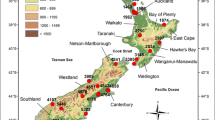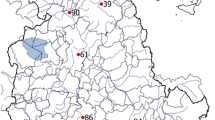Summary
Investigation of diurnal temperature data series in Hungary indicates that extreme anomalies often occur in groups. Periods which include at least 3–6 extreme anomalous days with 3–5 times higher frequency relative to the climatological average are referred to as periods of extremity (PE). Although PEs cover only 5–12% of the whole time-series (1901–1993), they include 40–90% of all days with extreme temperatures. This refers both to the positive and negative anomalies. This paper shows a method for delimitation technique of PEs which is more suitable for the revelation of time-sequence structure of extreme temperature value occurrences, than traditional investigations of daily or monthly values. As it was checked by Monte-Carlo simulations, a one step autoregressive model, exhibiting nearly normal distribution gives a fairly good approach of extreme temperature occurrences. However, significant differences between the statistical characteristics of real and simulated PEs are also experienced. Statistical connections between PEs and macrocirculation are also investigated.
Similar content being viewed by others
Author information
Authors and Affiliations
Additional information
Received November 12, 1996 Revised July 6, 1997
Rights and permissions
About this article
Cite this article
Domonkos, P. Statistical Characteristics of Extreme Temperature Anomaly Groups in Hungary. Theor Appl Climatol 59, 165–179 (1998). https://doi.org/10.1007/s007040050022
Issue Date:
DOI: https://doi.org/10.1007/s007040050022




